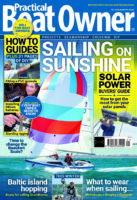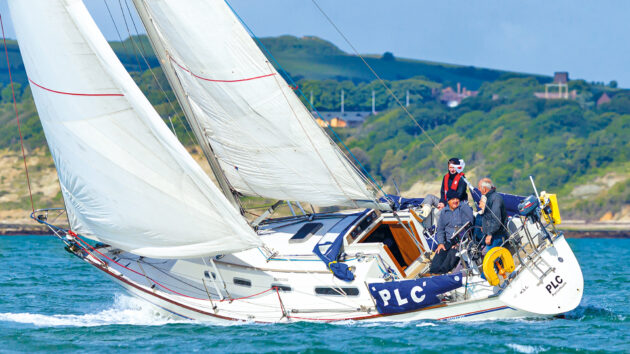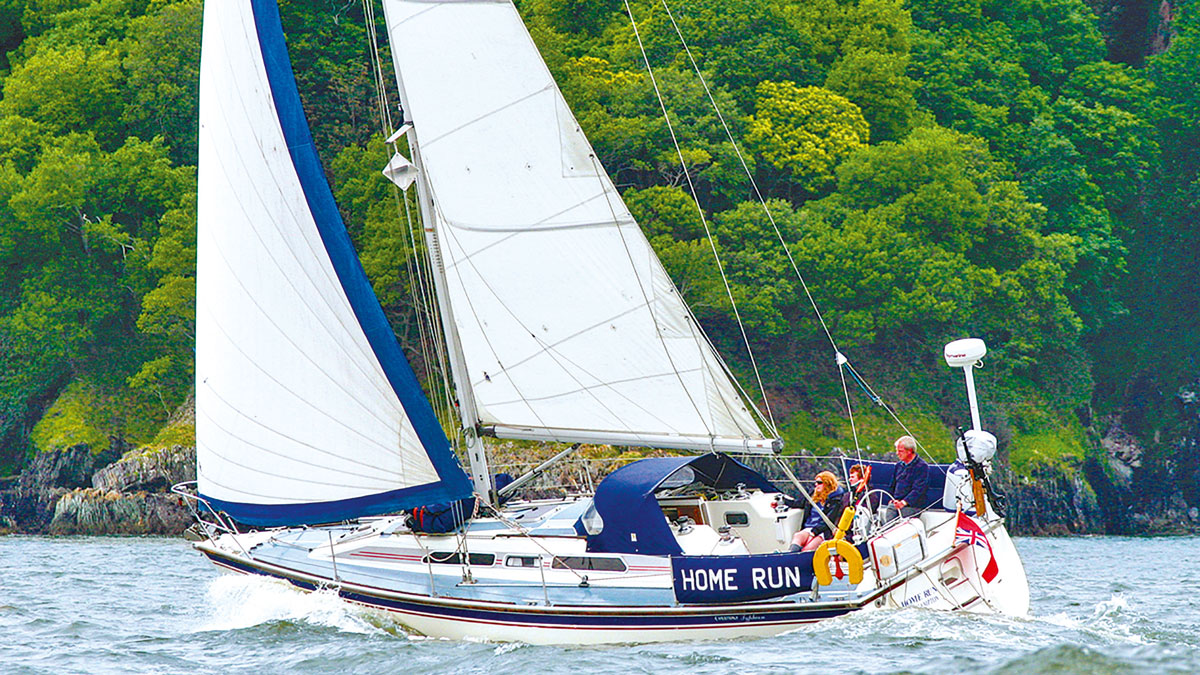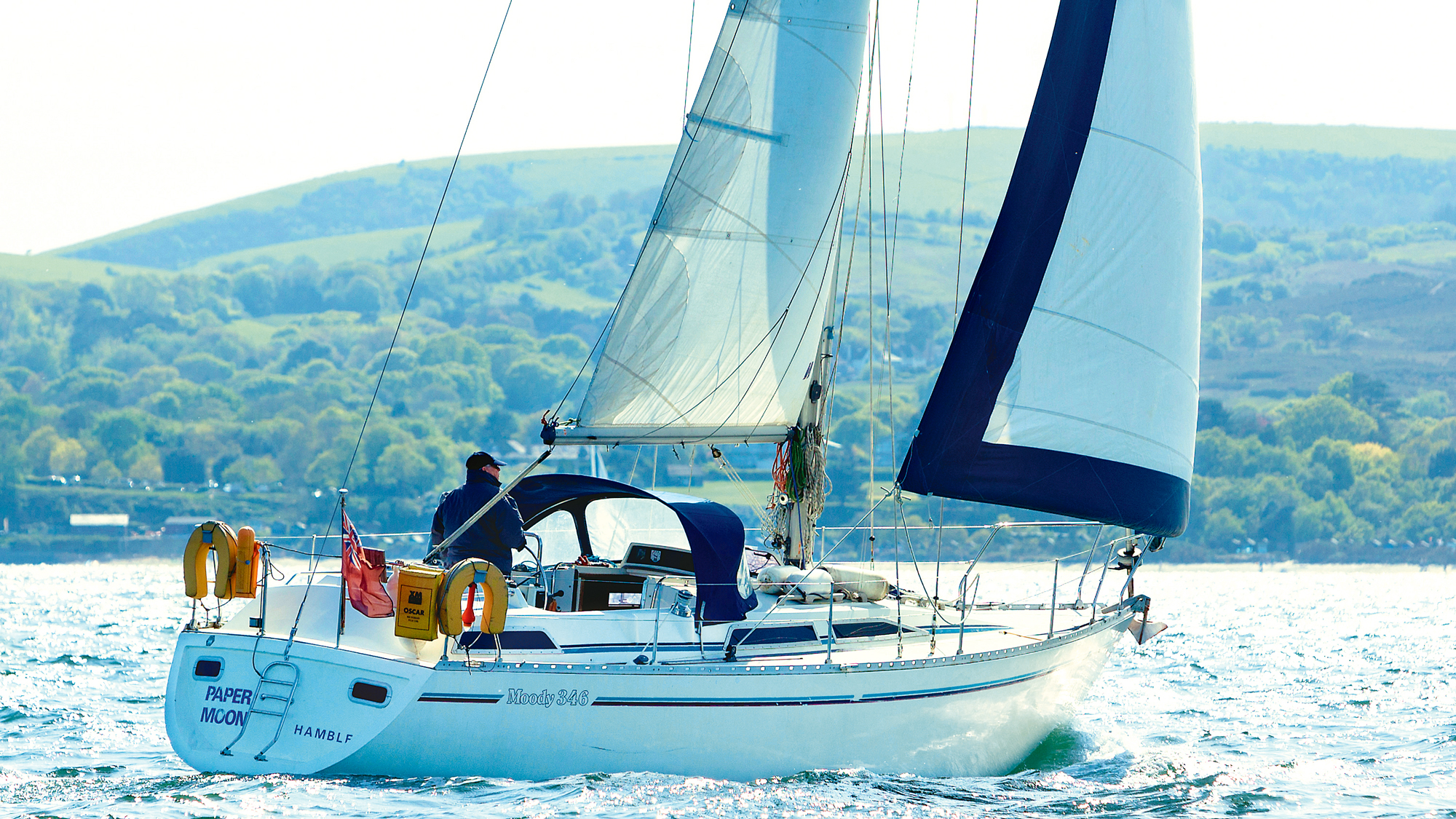Rupert Holmes looks at the Sadler 34, one of the most desirable cruising yachts of the Sadler era, as well as some alternative models including: Westerly Storm 33 | Sigma 362 | Beneteau First 345 | Jeanneau | Sun Rise | Dehler 34 | Catalina 34 | Hallberg-Rassy 34 | Etap 35i.
During the 1970s and 1980s, Sadler Yachts was one of the UK’s best-known boatbuilders, producing a range of serious sea boats that remain popular as cruising yachts today, including the Sadler 34.
In a sense, the firm grew out of the success of the David Sadler-designed long keel Contessa 26 from 1966 and the Contessa 32 of 1970.
Sadler’s son Martin subsequently founded his own yard in which the Sadler 25, also designed by his father, was built. This was followed by the Sadler 32 in 1979.
In many respects, this was a considerably updated Contessa 32, with more freeboard and accommodation volume, but still with good performance and sailing qualities.
The latter was proven in the 1979 Fastnet Race storm, which the boat survived without requiring outside assistance.
However, the one-design racing format that helped confer something of a cult status for the Contessa was missing.
Then the Sadler 29 and Sadler 26 updated the concept, with broader transoms than the Sadler 32 and decent accommodation for their length by the standards of the era.
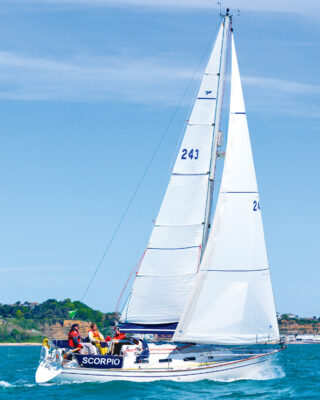
The Sadler 34 was offered with fin, twin, lifting and wing keels. David Harding.
They also introduced an unusual, but appealing, element – both boats were unsinkable thanks to a considerable volume of closed-cell foam sandwiched between the hull and an inner moulding. This also provided excellent thermal and acoustic insulation, making the boats more comfortable than many.
When it came to replacing the 32, Martin Sadler created the Sadler 34, which made its debut in 1984. As one of the Poole-based yard’s later models, the Sadler 34 was widely seen in the UK as one of the most desirable and capable cruising yachts of its era.
As with other Sadlers, the Sadler 34 was offered with a wide choice of keels, including three different fins, a wing keel, twin keels and a lifting keel. Most examples were fitted with either a deep (1.75m) or shallow (1.45m) fin. Later boats also had deeper and more efficient Stephen Jones-designed keels with a small bulb that further lowered the centre of gravity.
The Sadler 34
I sailed both the standard deep keel version and this one extensively in the early 1990s as a Yachtmaster instructor. The boat with the Stephen Jones keel markedly improved an already good design, making it easily a match for the Contessa 32 upwind in a blow and a lot less wet in big seas.
Accommodation is generally well laid out, with decent sea berths, galley and a proper chart table. It also includes a rather slim quarter cabin, which can sleep two at a push, but is far more comfortable as a spacious single.
This has to be a factor that dampened demand for the boat in later years, as does the more old-fashioned full-width heads compartment that separates the fore-cabin from the saloon, even though it was neatly executed.
Nevertheless, the Sadler 34 represented a big improvement on earlier designs, even if there’s less volume overall than models of a similar length from 10 years later.
The boat remained in production until the mid-1990s. Around 260 boats are believed to have been produced.
Sadler again turned to Stephen Jones for the 34’s replacement, the Sadler Starlight 35, which was a much more modern concept and also very well built, though not as many were sold.
Sadler 34 Specifications
- LOA: 10.60m/34ft 9in
- LWL: 8.50m/27ft 10in
- Beam: 3.30m/10ft 9in
- Draught: (std fin keel) 1.78m/5ft 10in
- Displacement: 5,800kg/12,800lb
- Ballast: 2,270kg/5,000lb
- Owners’ association: sadlerandstarlight.co.uk
Westerly Storm 33
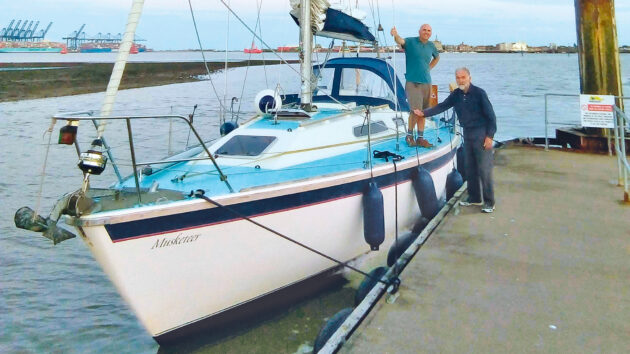
The high freeboard and increased beam means the Westerly Storm 33 has a decent amount of space down below. Photo: Nick Leather.
Once the dominant name in British boat building, Westerly had a reputation as a builder of solid, reliable and often rather heavy cruising yachts. But it was also responsible for a large number of race boats and performance cruisers.
These started with the GK24 in 1976, followed by the GK29 and GK33. In addition, from 1978 onwards, the firm built J/24s and J/29s under license.
In 1979, the yard turned to a new designer to create a 32-footer that would combine performance and heavy weather ability with a cruising interior and styling that was more coherent with the bulk of Westerly’s range.
The result was the Ed Dubois-designed Fulmar, which is considered by many as the best boat the company ever built, across the 70 models produced during almost 40 years of boatbuilding.
However, a more recent Westerly that also has many desirable qualities, yet is often overlooked, is the Storm 33.
This is another Ed Dubois design, dating from 1986, and was intended as a more up-to-date concept and a higher-performance boat that could be raced.
At the same time, it retained many of the marque’s core features, including extensive interior woodwork, where other yards at the time were using a lot of moulded sub-assemblies that were quicker and less costly to produce.
Although only a foot longer, an additional 8in (20cm) of beam, plus high freeboard, translated into a lot more interior space than the Fulmar.
In particular, the forecabin is larger, with a generous standing space aft of the berth, the toilet and shower compartment is conveniently aft next to the companionway, and there’s also a well-proportioned double aft quarter cabin.
In these respects, the Storm’s accommodation is also significantly better than that of the Sadler 34, despite its shorter overall length.
The boat also gained a reputation as being rewarding to sail and capable offshore even if, in reality, few owners regularly ventured out onto the race course.
Nevertheless, the Storm sold in smaller numbers than the Fulmar, with a total of 241 boats built across four variants, including the Storm Cruiser, Regatta 330 and Ocean 33, by the time of Westerly’s final demise in 2000.
Westerly Storm 33 Specifications
- LOA: 10.10m/33ft 2in
- LWL: 8.23m/27ft 0in
- Beam: 3.50m/11ft 7in
- Draught: 1.70m/5ft 6in
- Displacement: 5,130kg/11,310lb
- Ballast: 1,900kg/4,210lb
- Owners’ association: westerly-owners.co.uk
Sigma 362
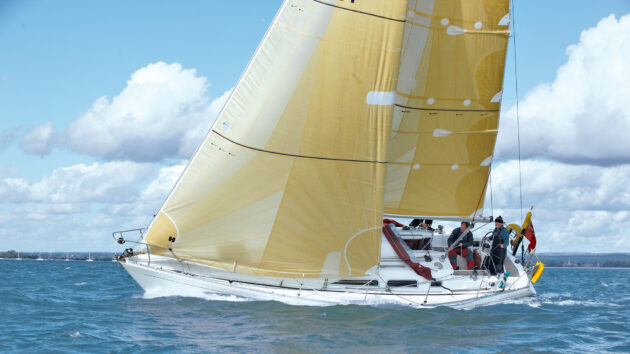
The Sigma 362’s powerful rig delivers great performance and can be comfortably handled short-handed. Photo: Graham Snook / Future PLC.
Launched in 1983, the Sigma 362 is another more performance-oriented option, yet has a comfortable, fully fitted two-cabin interior with a large galley and aft heads.
As with the First 345, this model was based on a successful racing hull, in this case, the David Thomas-designed Sigma 36 from 1980.
In those days, the original boat’s 1.96m (6ft 5in) draught was still considered to be very deep, so a slightly shallower fin than that of the Sigma 36 was fitted to deep-draught boats, while a shallow fin of 1.5m (4ft 11in) was also offered. A number of boats were fitted with an even shallower wing keel. At the same time, the lofty fractional rig of the original was replaced with a more moderate masthead rig with a smaller sail area.
A new deck moulding created a more comfortable cockpit for cruising, including wheel steering, and enabled a new interior that closely matched boats of the period from European manufacturers. This created a thoroughly desirable and comfortable yacht that can be set up to be easy to handle, yet also put in quick passage times, even when sailed short-handed.
The result is one of the most appealing British-built boats of its era. It’s a desirable fast passage maker that combines performance and great handling with comfortable, well-planned accommodation that has stood the test of time. A full test of the Sigma 362 can be found in PBO’s November 2022 issue.
Sigma 362 Specifications
- LOA: 10.97m/36ft 0in
- LWL: 8.70m/28ft 6in
- Beam: 3.51m/11ft 6in
- Draught: 1.50m/4ft 11in or 1.90m/6ft 1in
- Displacement: 5,600kg/12,400lb
- Ballast: 2,350kg/5,150lb
- Mainsail: 25.8m2/280ft2
- Foretriangle area: 29.5m2/320ft2
Beneteau First 345
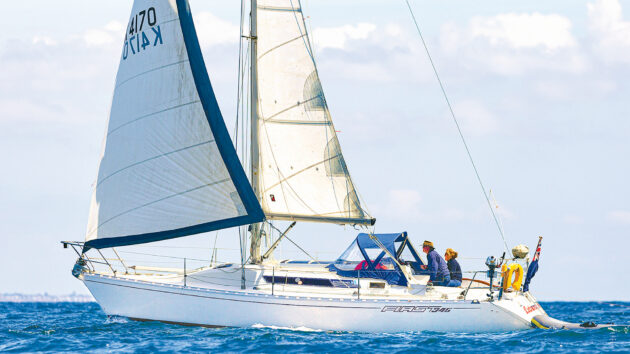
First 345 is a moderate displacement cruiser/racer; being able to blend these two functions meant it was a popular design. Photo: David Harding.
I’ve mentioned this model from 1984 several times in PBO for good reason.
It remains one of my favourite designs of this size and era, right from when I sailed a well-used five-year-old example for my Yachtmaster Instructor assessment week as an enthusiastic 22-year-old.
In particular, a feisty trip out of the Needles Channel and across Poole Bay in a westerly Force 5-6 against a spring ebb tide stood out for me at the time. With a No3 jib and two reefs in the mainsail, the boat was simultaneously extremely comfortable and an absolute pleasure to helm. It’s also a boat with the ability to look after you in more testing weather. Yet at the same time, in lighter airs later that week it also proved to be surprisingly quick and nimble.
In addition, this is another of the boats that set new standards for interior accommodation, both in terms of layout and a big boost to natural light thanks to extensive glazing overhead.
The three-cabin version has the same layout as the more race-oriented First 35 of 1980 that was based on the same hull. However, two-cabin versions of the 345 had a new arrangement, with the heads moved aft near the companionway, allowing for a much larger forecabin, with good standing space and stowage. The double quarter cabin is also larger than those of three-cabin boats.
The 345 was part of a range of eight third-generation First models from 23-43ft, all with model names ending in 5. Despite the performance bias of this range, all models were also hits with both cruising owners and charter companies.
Beneteau First 345 Specifications
- LOA: 11.00m/36.09ft
- LWL: 8.90m/29ft 2in
- Beam: 3.50m/11ft 6in
- Draught: 1.40 or 1.85m/4ft 7in or 6ft 1in
- Displacement: 5,700kg/12,600lb
- Ballast: 2,050kg/4,520lb
- Website: beneteau.com
Jeanneau Sun Rise
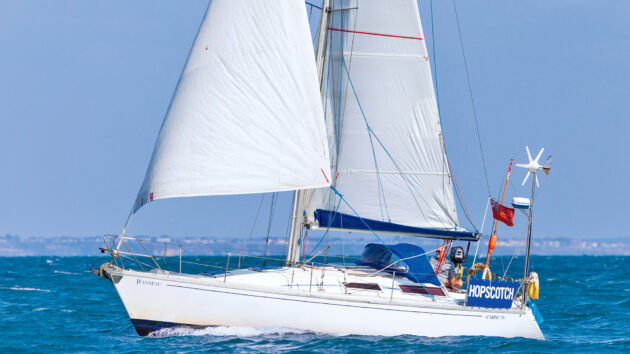
The Jeanneau Sun Rise was offered with a choice of wheel or tiller steering. Photo: David Harding.
This 1984 Jacques Faroux 34-footer also has its roots in a successful race boat, and is a tangibly lighter, yet more powerful boat than the Sadler 34.
However, it also has comfortable accommodation for cruising in a choice of two or three cabin layouts that offer some advantages over the British design, as well as more internal volume.
The Sun Rise dates from before Jeanneau was part of Groupe Beneteau so was a direct competitor for the First 345. Interior volumes are similar, though the Jeanneau has lighter displacement and less ballast, even though the rig is a similar size. Nevertheless, unlike some wide-stern designs, the hull shape remains nicely balanced, and the large rudder, hung on a half skeg, provides good control.
A choice of tiller and wheel steering was offered – don’t be deterred by boats with the former, although fashion now dictates that almost every boat of this size has wheel steering, loads in the helm are not excessive even for family crews.
Three-cabin boats have two double quarter cabins and the heads also near the companionway, opposite a large L-shaped galley.
However, this version feels a little cramped compared to the two-cabin model, which tends to be preferred by private owners.
More than 600 boats were built in total, making this a more popular model by far than the Sadler 34, especially in mainland Europe, though there’s also a good number of UK-based boats.
Jeanneau Sun Rise Specifications
- LOA: 10.55m/34ft 7in
- LWL: 8.99m/29ft 6in
- Beam: 3.50m/11ft 6in
- Draught (std keel): 1.8m/5ft 11in
- Displacement: 4,700kg/10,362lb
- Ballast: 1,540kg/3,395lb
- Owners’ association: www.jeanneau-owners.com
Dehler 34
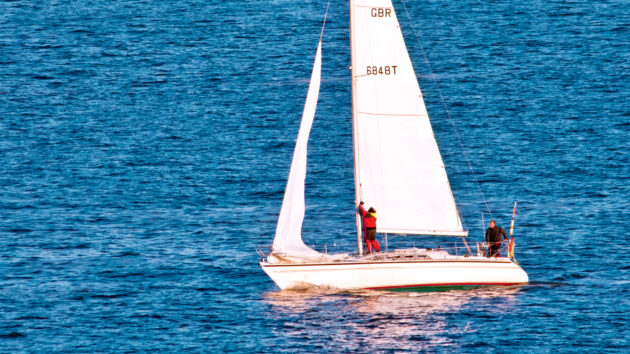
The Dehler 34 has a typical performance hull with a long, slim waterline plane, low topsides and a high coachroof. Photo: SPK / Alamy.
This easily handled and robust fast cruiser, based on the hull shape of the successful Van de Stadt-designed Dehler DB1 and DB2 race boats, was also enormously popular, with some 1,300 built between 1983 and 1993. A huge number of modifications were made during the production run, with later boats in particular being ahead of their time in many respects.
Nevertheless, early examples had a traditional interior layout with a full-width heads compartment separating the fore-cabin from the saloon.
After three or four years this was changed to a more modern arrangement with an aft heads and the aft double quarter berth enclosed in a separate cabin. But neither the waterline length nor the beam is generous, so the accommodation volume is not huge for a boat of this size and era.
This doesn’t appear to have dented the boat’s appeal, and the upside of the hull shape is a beautifully balanced and easily driven boat that slips along easily in light airs and yet is a capable design in heavy weather.
Two further Dehler 34s followed the original. A more race-oriented model, the 34RS, was launched in the early 2000s while the 2017 Dehler 34 is a contemporary twin-rudder design that blends excellent performance from a powerful hull shape with accommodation that, 30 years ago, would not have seemed possible in a quick and well-mannered boat of this size.
However, neither version sold in anything like the numbers of the original design. Given the long production run and that newer boats are of a higher specification, with a better interior layout, examples of the original Dehler 34 tend to change hands at a wide variety of prices.
Dehler 34 Specifications
- LOA: 10.10m/33ft 2in
- LWL: 8.30m/27ft 3in
- Beam: 3.40m/11ft 2in
- Draught: 1.70m/5ft 7in
- Displacement: 4,000kg/8,800lb
- Website: www.dehler.com/gb
Catalina 34
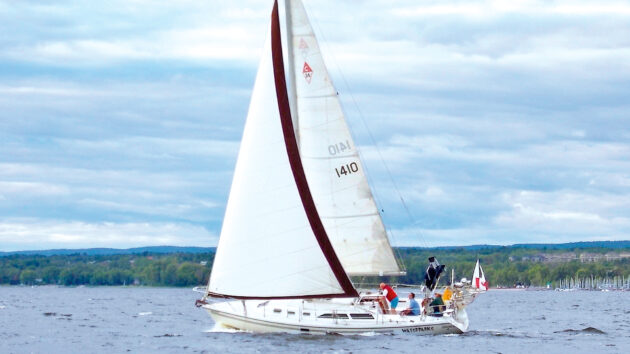
The Catalina 34 had several marks, each one improving on the original design, including a wider transom. Photo: Archive PL / Alamy Stock Photo.
Huge numbers of these American cruisers were built over two decades, starting in 1985, making it one of the most popular of this size. Spacious accommodation was a key part of the appeal, including the separate aft cabin with a large transverse berth and a generous aft heads compartment.
The saloon feels big for a 34-footer, with an impressive maximum headroom of 1.93m (6ft 4in).
There’s a large table to starboard with wrap-around seating that can be converted to a 2.0m x 1.42m (6ft 7in x 4ft 8in) berth. To port is a settee of the same length, the aft end of which forms the seat for an aft-facing chart table. Both sleeping cabins are of a good size, and no berths are shorter than 2.0m (6ft 7in).
A continuous process of improvements helps explain the model’s long production run.
In the early 1990s, for instance, the transom was redesigned to provide walk-through access from a new bathing platform.
In 1995 came a more significant rethink as the design was beginning to look dated, and there was less cockpit space than newer rivals. Catalina, therefore, tweaked the aft sections of the hull above the waterline to give more flare and increase beam at deck level.
At the same time, a sleeker deck moulding was produced and the boat was renamed the Catalina 34 Mkll. The interior also benefited from better joinery, a new heads moulding and improved galley worktop.
All versions were sold with a much higher standard of factory-fitted inventory than was common with European boats of similar vintage, including a shorepower system, holding tank and pressurised hot and cold water. Later boats also had electric windlasses and refrigeration as standard.
All boats had a choice of tall and standard rigs, with a 0.9m (3ft) difference in height between them and deep or shoal fin keels. Later on, a shoal draught wing option was also added.
I sailed a late 1990s wing keel model with the standard rig when it was around three years old, in winds ranging from 12-23 knots. It proved to be a stiff boat, comfortably holding full mainsail and headsail with just two rolls in up to 17-18 knots apparent breeze when close hauled.
Once the wind increased beyond this level, the boat felt overpressed and weather helm increased, but the single-line mainsail reefing makes reducing sail easy, and overall it has the feel of a solid and predictable vessel.
Different sources give varied figures for the numbers built, with some stating just under 1,500. However, in 2002, the then UK agent told me 1,700 had already been built. Production continued until 2008, though it’s likely that fewer boats were built in later years.
Catalina 34 Specifications
- LOA: 10.50m/34ft 6in
- LWL: 9.10m/29ft 10in
- Beam: 3.60m/11ft 9in
- Draught (deep fin): 1.70m/5ft 7in
- Ballast (deep fin): 2,271kg/5,008lb
- Displacement (deep fin): 5,421kg/11,950lb
- Sail area (std rig): 49.1m2/528ft2
Hallberg-Rassy 34
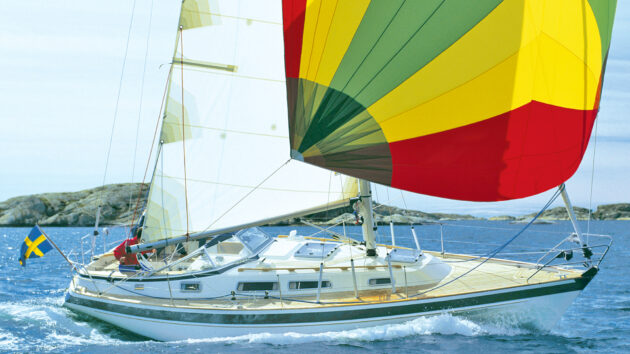
The Hallberg-Rassy 34’s cockpit is large and deep but the footwell is good for bracing when heeling. Photo: Hallberg-Rassy.
This is a slightly later and more expensive option that was built from 1990. Nevertheless, it’s likely to appeal to anyone who values the core qualities of the Sadler 34 but has a larger budget.
It’s a German Frers design that’s sufficiently large, well constructed and stable to go almost anywhere, while being small enough to be easy to handle and avoid the big bills that big boats attract.
A finely balanced hull shape, big rudder and deep, low centre of gravity keel combine to create a quick boat with flawless handling.
Interiors were fitted out to a very high standard, with well-organised stowage, two double cabins, a proper chart table and a large galley. While the layout is unashamedly modern, it’s also configured to be safe and easily worked at sea.
A 16-year production run saw a progression of improvements that refined both ergonomics and the standard of fit out. Although this was an expensive yacht for its size, an impressive 500 boats had been sold by the time it was phased out in 2005.
Today, it’s not surprising that the HR34 has held its value very well compared to other models of its era, although boats that are in need of a replacement teak deck should be priced or bargained for accordingly.
Hallberg Rassy 34 Specifications
- Hull length: 10.28m/33ft 9in
- LWL: 8.69m/28ft 6in
- Beam: 3.42m/11ft 3in
- Draught: 1.85m/6ft 1in
- Displacement: 5,300kg/11,684lb
- Website: www.hallberg-rassy.com
Etap 35i
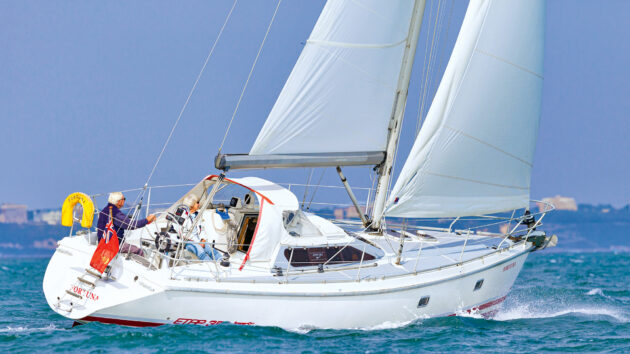
Closed-cell foam between the Etap 35i’s inner and outer mouldings makes her almost unsinkable. Photo: David Harding.
This is a later 1992 fast cruiser designed by Alain Mourtain and the legendary French naval architect Philippe Harlé that shares an unusual characteristic with the Sadler 34. It’s also an unsinkable boat thanks to exactly the same philosophy of installing closed-cell foam between inner and outer mouldings.
It’s a more modern concept in a number of respects, including a 9/10ths fractional rig and interior layout with aft heads, plus a double quarter cabin.
In 1997, this model morphed into the Etap 34S. Changes included a sleeker but longer coachroof that improved headroom forward of the mast at the expense of the previous flat foredeck.
In addition, the fore-cabin berth was moved forward, making it narrower at the foot end, but creating a useful standing area at the head of the bunk and improving easily accessible stowage. It also has a more efficient, deeper bulb keel and a more powerful spade rudder.
In addition to the innovative construction, the Belgian yard was renowned for quality production and attention to detail.
Etap 35i specifications
- LOA: 10.62m/34ft 10in
- LWL: 8.84m/29ft 0in
- Beam: 3.51m/11ft 6in
- Draught: 1.55m/5ft 1in
- Ballast: 1,740kg/3,836lb
Rupert Holmes has sailed 85,000 miles in more than 250 different boats. He won the 2022 Sevenstar non-stop round Britain and Ireland race and is currently preparing for the Globe 40 double-handed round the world race.
Comparing the Westerly Typhoon 37 and 6 other designs
Rupert Holmes looks at the the Westerly Typhoon 37, his favourite Westerly model of all time, and other alternative boats…
Best centre cockpit sailboat designs: the Moody 34 and 346 + 5 alternative yachts
The Moody 34 and 346 were the smallest and best-selling of Moody’s centre cockpit sailboat models in the 1980s. Rupert…
Want to read more articles about the Sadler 34 and other models?

A subscription to Practical Boat Owner magazine costs around 40% less than the cover price.
Print and digital editions are available through Magazines Direct – where you can also find the latest deals.
PBO is packed with information to help you get the most from boat ownership – whether sail or power.
-
-
-
- Take your DIY skills to the next level with trusted advice on boat maintenance and repairs
- Impartial, in-depth gear reviews
- Practical cruising tips for making the most of your time afloat
-
-
Follow us on Facebook, Instagram, TikTok and Twitter

